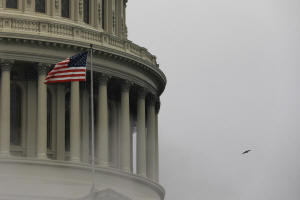Return of pet projects in U.S. Congress crowds out funding for others
 Send a link to a friend
Send a link to a friend
 [September 29, 2022]
By Andy Sullivan [September 29, 2022]
By Andy Sullivan
(Reuters) - Glen Ullin, North Dakota, was
first in line for money to replace its leaky water pipes before
Washington cut funding by one-third this spring. The reason: Congress is
yet again diverting money to pet projects known as "earmarks.
Advocates say these earmarks allow lawmakers to direct money where they
believe it is needed most.
But they leave less money for everybody else.
Water projects in West Virginia, Alaska and Oklahoma will get more than
twice as much money this year as last, thanks to earmarks secured by
their congressional representatives.
That leaves states like North Dakota that did not get earmarks unable to
fund as many projects as they had anticipated -- even as President Joe
Biden's infrastructure law has secured $50 billion more for that
purpose.

"Earmarks are a problem I wish people could see. It's just quite drastic
-- winners and losers," said DeAnn Ament, who heads North Dakota's
public-finance authority.
Earmarks serve as legislative “sweeteners” that build support for major
bills by allowing lawmakers to steer federal dollars to projects in
their districts, bypassing the bureaucracies that usually distribute
federal aid.
A series of corruption scandals and concerns about wasteful spending
prompted Congress to abolish earmarks in 2011. But as partisan funding
battles led to repeated government shutdowns over the following decade,
some lawmakers pushed for their return, arguing they could build support
for the massive spending bills that keep government running.
NEW SAFEGUARDS
Democrats included new safeguards when they brought earmarks back last
year. Lawmakers have to post their requests online and certify that they
do not have a financial stake in the projects they propose. Earmarks are
capped at 1% of discretionary spending, and cannot go to for-profit
entities.
The annual government spending bill Biden signed in March included 4,983
earmarks, ranging from $133 million to upgrade port facilities in
Alabama to $4,000 to buy a vehicle lift for the Huntington, West
Virginia, police department.
That money was not distributed evenly: Alaska and Vermont pulled in more
than $300 worth of earmarks per resident, according to a Reuters
analysis, while North Dakota, Wyoming and Montana got no earmarks at
all.
Congress increased the overall funding to some programs to cover the
costs of earmarks.
That's not the case with the two Environmental Protection Agency
programs that fund local drinking-water and wastewater projects.

Congress provided $2.76 billion for the 2022 fiscal year, a slight
increase over the prior year. But that included $841 million in
earmarks, which reduced by 30% the amount available to state-run funds,
which weigh criteria like affordability and health risks when they
decide which projects to support with grants and low-interest loans.
Some states say that is not a problem.
The infrastructure law provides an additional $3.8 billion each year for
water projects over the next five years, along with money to remove lead
pipes and tackle "forever chemicals" that have emerged as a new
environmental concern.
That means even states like North Dakota and Arkansas that did not
secure water-system earmarks will have twice as much money this year,
the Reuters analysis found.
[to top of second column]
|

A bird flies by the United States
Capitol building in Washington, U.S., March 17, 2022. REUTERS/Emily
Elconin

"We're doing much better than previous years," said Chris Colclasure,
who heads Arkansas' natural-resources office.
Others say the cuts will have a lasting impact.
"Those projects that got the earmarks really did jump in front,"
said Keith McLaughlin, head of Colorado's water-development
authority. Even with the extra infrastructure dollars, his state's
water funds will probably run out of money in the coming year, he
added.
Earmarks allow local governments to bypass those state-run funds.
In New Jersey, several towns that would be normally too affluent to
qualify for state grants secured earmarks anyway.
Saddle River, a New York City suburb where the median household
income is two and a half times the national average, won a $1.1
million earmark to build a sewer line to a new housing development.
The town would not qualify for a grant through the existing state
program and did not apply for low-interest financing, according to a
state official.
Saddle River did not respond to a request for comment. Democratic
Representative Josh Gottheimer, who helped secure the earmark, said
he believed it was his duty to steer as much federal aid as possible
back to his district.
"The more of our federal tax dollars that we get back to Jersey
towns, the less our towns and families have to carry the burden in
local taxes," he said in a statement.
That wasn't an option in North Dakota, whose congressional
delegation did not submit any earmark requests this year or last.
Republican Senator Kevin Cramer said he has asked to ensure that
states like his don't get less funding if they do not secure
earmarks. The state's other senator, Republican John Hoeven, said he
has been able to adequately fund North Dakota's needs without
earmarks.
That would have been the case for Glen Ullin, located 54 miles (86.9
km) west of Bismarck, had North Dakota gotten he same amount of
money it did last year.

The city ranked first on the state's list of eligible projects, due
to the poor condition of its water system and a median household
income that is half the national average.
State officials said they planned to award the city a grant of $2.2
million and a low-interest loan to cover the remainder of the $4.5
million project.
In May, the state learned it would only get $7 million for its
drinking-water fund, down from $11 million the prior year.
That forced it to slash its grant for Glen Ullin to $1.4 million.
Glen Ullin probably won't qualify for infrastructure dollars because
those are distributed using different criteria, officials say.
The city has scaled back its plans. Backhoes could start digging up
some streets next spring to install new pipes, but nobody knows when
they'll be able to finish the job.
"Of course it's not fair. But I wouldn't be whiny about it," said
Vicki Horst, the city auditor. "We'll keep working and see what we
can do."
(Reporting by Andy Sullivan in Washington; Editing by Scott Malone
and Alistair Bell)
[© 2022 Thomson Reuters. All rights
reserved.]
This material may not be published,
broadcast, rewritten or redistributed.
Thompson Reuters is solely responsible for this content.
 |